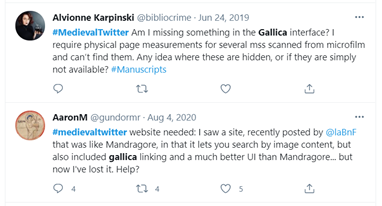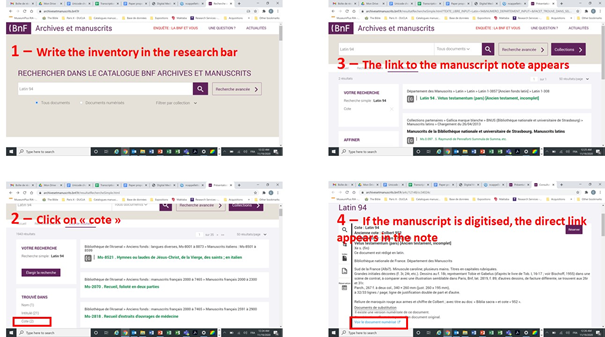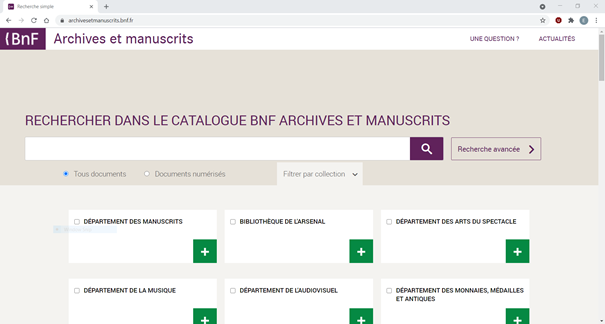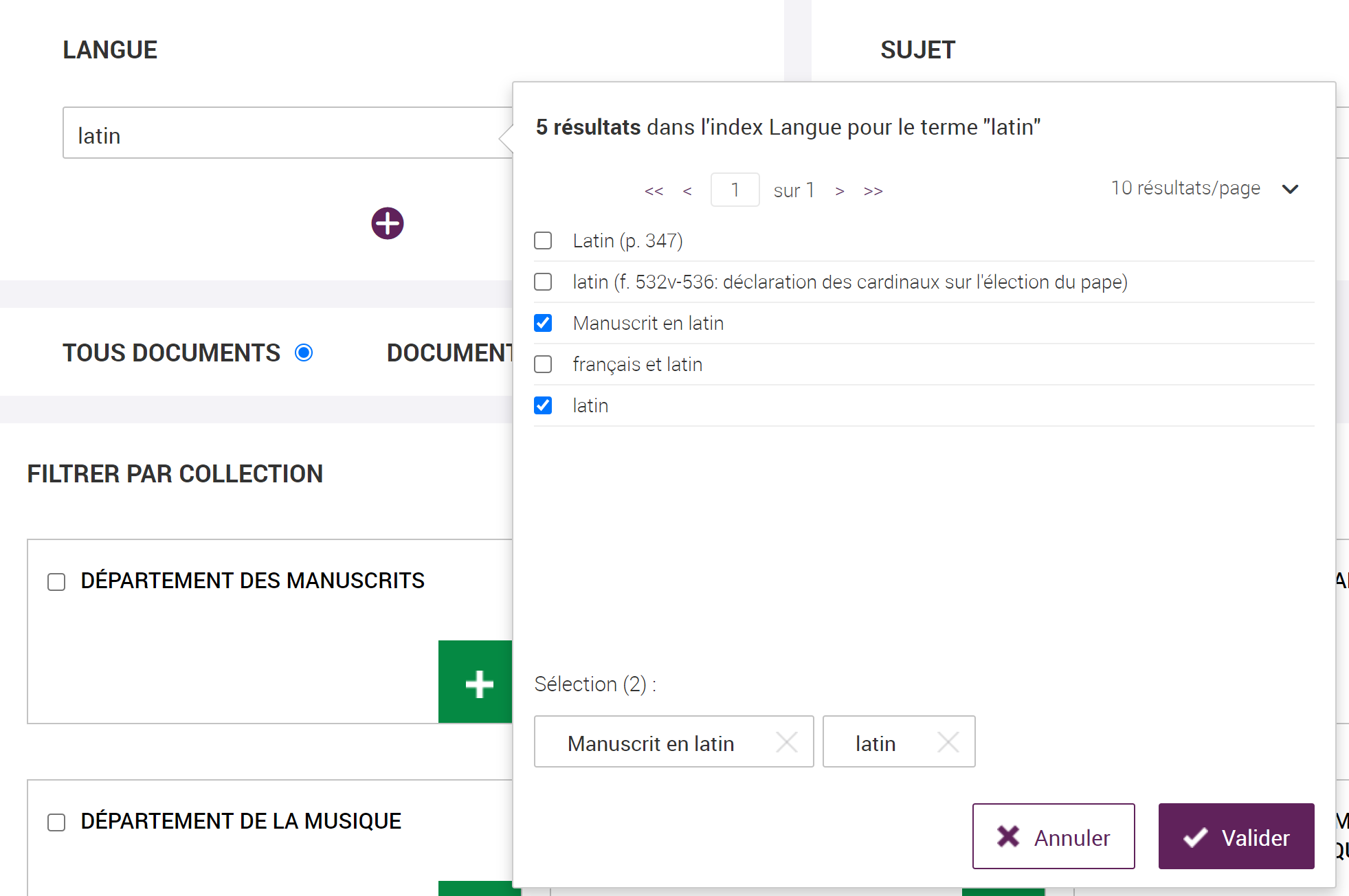Bible hunting: where to find data? The case of France. A series
Finding resources, organising and using them might sometimes be a struggle. Having worked at the Bibliothèque nationale de France (BnF) a few years ago during my studies, I learnt what (French) resources existed and how to use them. Seeing people struggle online (hello #medievaltwitter) made me realise how lucky I had been, given how challenging it can be to understand what resources exist and how to access them, particularly for non-native speakers.



On our path to building a database of known (in catalogues) but also digitized and freely accessible Paris Bibles, we had to check many databases from several countries, use their search tools and try to gather what we could. What we offer here is a series of blog posts providing not only a list of manuscripts and illumination databases – this has been done before – but also some tips and tricks on how to use them.
Starting at the Bibliothèque nationale de France
The BnF provides many qualitative resources. It is indeed one of the best places to find manuscripts and illuminations, that is, if you know where to look. People are usually familiar with Gallica, the digital library established in 1997 with more than 6 million records including about 150,000 manuscripts (out of the 1,220,000 kept in the closed stacks). But it is not the only resource available.
If you are interested in manuscripts, the catalogue “Archives et manuscrits” is THE place to go. Created in 2007, it gathers every manuscript, not only in the main BnF collection (including the manuscripts department) but also the Bibliothèque de l’Arsenal, and several other departments: Département de la Musique, Réserve et Livres rares, etc.
But, how can you make best use of it? Archives et manuscrits is particularly useful when you know what you want. If you have the inventory number of the manuscript you are looking for, just follow these next steps.

The manuscript description (“note”) gathers data about the manuscript itself (codicology, palaeography, history, etc.), but also bibliography AND links to any digitised copy existing, both high-resolution and digitisation of microfilm, and sometimes both, and then you are sent back to Gallica to consult the digital copies.
Archives et manuscrits also offers advanced search. It is less precise than the search by inventory number but allows you to search using more general terms. It can be useful when you don’t know exactly what manuscript you want, rather a certain typology, date, location or language. You can also look for keywords, titles or authors and copyists. The search interface is only in French (although some search terms are found in Latin or other languages).
On the general search interface, you can choose to search only for digitized manuscripts (select “Documents numérisés” instead of “Tous documents”) or the department you wish to look at (click on “Filtrer par collection” and then select the department(s) you want).

For the advanced search, click on “Recherche avancée”. Then, you can either search by keywords (“TOUS LES MOTS”) or by specific entries. There, it can become tricky. Let’s say, we want to find all the digitised Latin Bibles from the thirteenth century. We will have to use several fields.
First, we are looking for Bibles, so we will use it as a keyword because it will look for it in the full metadata. Bibles are often referred to, and catalogued under, other names. Using the “Intitulé” field (title) might result in many manuscripts missed by the search while. NB:”Titre d’oeuvre” only works for literary texts e. e.g. “L’image du monde”, “Le roman de Renart”, etc.).
In the “Date” field, we translate the 13th century into the beginning and end years of the century, i.e. 1201 and 1300.
We also want Bibles only in Latin and no other languages. So in “Langue” (language), let’s write “latin” and click on the grey search icon. A list of vocabulary appears and you can select the relevant ones for your search and validate. In our case, it creates two lines with the selected vocabulary.

Lastly, we only want digitised manuscripts, which is the easiest as we only have to select “documents numérisés” instead of “tous documents”.
You can also choose in which collections you want the engine to search. If you leave this field blank, it will look into every one of them. But let’s say, we only want to look at the Latin section of the Manuscript department, we can click on the plus under “Département des manuscrits”, scroll down and select “latin”.
When you’re ready, click on “Rechercher” at the end of the page. If you have followed the steps we’ve just described, you should get at least 249 results (maybe more if you are reading this in a few months or years and more manuscripts have been digitised).
And the other resources?
The other very useful resource created by the BnF is called Mandragore. It was created in 1989 (!) and continues to be enriched on a daily basis thanks to the fantastic job of the curators, librarians and researchers from the BnF. Unlike Archives et manuscrits, Mandragore is not a catalogue, but rather an iconographic database. It describes the decoration of more than 6,700 manuscripts from the Manuscripts department and the Bibliothèque de l’Arsenal, for more than 200,000 manuscript descriptions (of which 150 000 have images associated with them).
Mandragore is great, but Mandragore is old and somewhat difficult to use. It is based on a controlled vocabulary of more than 20,000 descriptors. You need to know precisely what you want or you might miss relevant data. But we have good news: all data from Mandragore, but also from other French databases are accessible through the Biblissima portal, which is IIIF compliant and super user-friendly.
What is Biblissima?
Biblissima aggregates the data from other databases and catalogues, many of them developed by the IRHT (Institute for Research and History of Texts). It is a collective effort, gathering resources and work from the Archives nationales de France, Bibliothèque nationale de France, IRHT, École des Chartes, École pratique des Hautes Etudes and other Research Centres and Universities.
At the time of the publication of this post, Biblissima includes notably:
Bibliothèque virtuelle des manuscrits médiévaux - BVMM (IRHT-CNRS) - digital reproductions of medieval manuscripts preserved in municipal and university libraries in France.
Initiale (IRHT-CNRS) - Catalog of illuminated manuscripts.
Enluminures (IRHT-CNRS) - more than 120,000 images, digital reproductions of illuminations and decorative elements from more than 5,000 medieval manuscripts preserved in about 100 French municipal libraries.
Europeana Regia (BnF, BSB, BHUV, HAB, KBR) - Virtual library covering the major royal collections of manuscripts in Europe during the Middle Ages and the Renaissance.
Manuscripta Medica (SAPRAT-EPHE, CIHAM) - Latin medical manuscript database.
RegeCart (IRHT-CNRS) - Repertories of cartularies.Medieval manuscripts from the Library of Wellcome Collection (Wellcome Library, Londres).
Pinakes (IRHT-CNRS) - Database of Greek manuscripts.
Comparatio (IRHT-CNRS) - Database on medieval liturgical chants.
Bibale (IRHT-CNRS) - Describe the history of the transmission of manuscripts and the texts they contain through the study of ancient and modern collections, and that of their owners.
Gloss-e (IRHT-CNRS) - Corpus of several tens of thousands of sentences or brief explanations, arranged in the margins and the line of the text of the Bible.
Jonas (IRHT-CNRS) - Gathers information on medieval French and Occitan handwritten literary traditions.
Mandragore (BnF) - Base of illuminated manuscripts of the BnF.
BnF Archives et Manuscrits - Catalogue of manuscripts of the BnF.
The complete list of resources accessible through Biblissima is accessible here.
We hope that these suggestions are helpful for your searches in French digital collections of manuscripts.
If you have additional suggestions for exploring collections in France not covered here or additional tips, drop us a line at parisbible(at)gmail(dot)com.
Estelle Guéville
Suggested citation
Guéville, Estelle. (31 August 2021). Bible hunting: where to find data? The case of France. Paris Bible Project. https://doi.org/10.5281/zenodo.8040632
This post is published with a CC BY-SA-NC 4.0 International license.